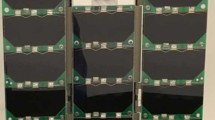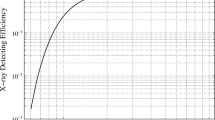Abstract
GOES (Geostationary Operational Environmental Satellite) X-ray sensors observe the Sun continuously in two broadband soft X-ray channels. These data are collected in real time and are used operationally to detect the onset and the intensity of solar flares. For these purposes it is usually sufficient to monitor only the soft channel (1–8 Å). The second, harder channel (0.5–4 Å) provides additional information on the state of the coronal plasma. The dual X-ray measurement data are archived and made available to external users for basic research.
The GOES X-ray sensors operate on the ion-chamber principle: measured ion-chamber electric current is proportional to the net ionization rate caused by incident X-ray flux on encapsulated noble gases. The ratio of the outputs of the two channels in electric current, therefore, is uniquely a function of the color temperature of the emitting plasma, and the magnitude of each of the currents is proportional to a quantity, known as the emission measure, that convolves the volume and the density of the emitting plasma.
This paper provides a detailed description of the procedure used for computing color temperature and emission measure from GOES X-ray data, including a table of constants for SMS and GOES X-ray sensors that are necessary for reducing the archived data from these satellites. Temperature and theoretical current tables were constructed, for individual GOES sensors, from laboratory calibrations of instrument responses and from synthetic solar X-ray spectra generated by two models of solar thermal X-ray emission: Raymond-Smith and Mewe-Alkemade. Example tables are shown and others are available on request.
Errors that may be incurred from the use of GOES X-ray data in the computation of flare temperatures and emission measures may be classified under four major groups: instrumentinduced errors, including errors of calibration and random measurement errors; environmentally induced errors, due primarily to the ambient energetic electron background; solar influences, including the consequences of the isothermal assumption and the single-source assumption; and uncertainties in the modelled solar synthetic spectrum. These error sources are discussed separately, and a rough estimation of the collective error is made where this is quantitatively feasible. Finally, temperatures and emission measures are computed from GOES data and are compared with those derived from SMM andHinotori soft X-ray spectrometer data and from broadband photometric data from the PROGNOZ satellite.
Similar content being viewed by others
References
Antonucci, E., Gabriel, A. H., and Dennis, B. R.: 1984,Astrophys. J. 287, 917.
Bornmann, P. L.: 1990,Astrophys. J. 356, 733.
Craig, I. J. D. and Brown, S. C.: 1976,Astron. Astrophys. 49, 239.
Culhane, F. L.: 1969,Monthly Notices Roy. Astron. Soc. 144, 375.
Culhane, F. L. and Acton, L. W.: 1970,Monthly Notices Roy. Astron. Soc. 151, 141.
Donnelly, R. F. and Unzicker, A.: 1974, NOAA Tech. Memo. ERL SEL-31.
Donnelly, R. F., Grubb, R. N., and Cowley, F. C.: 1977, NOAA Tech. Memo. ERL SEL-48.
Garcia, H. A.: 1985, NOAA Tech. Memo. ERL SEL-72.
Garcia, H. A.: 1994, in preparation.
Garcia, H. A., and Fárník, F.: 1992,Solar Phys. 141, 127.
Garcia, H. A. and McIntosh, P. S.: 1992,Solar Phys. 141, 109.
Grubb, R.N.: 1975, NOAA Tech. Memo. ERL SEL-42.
Kahler, S. W.: 1991,Solar Phys. 133, 371.
Mewe, R.: 1972,Solar Phys. 22, 459.
Mewe, R., Gronenschild, E. H. B. M., and van den Oord, G. H. J.: 1985,Astron. Astrophys. Suppl. Ser. 62, 197.
Mewe, R., Lemen, J. R., and van den Oord, G. H. J.: 1986,Astron. Astrophys. Suppl. Ser. 65, 511.
Panametrics, Inc.: 1978,Panametrics Report PANA GOES X-SR-1, Waltham, MA.
Panametrics, Inc.: 1987,Panametrics Report PANA-NOAA-1, Waltham, MA.
Rosner, R., Tucker, W. H., and Vaiana, G. S.: 1978,Astrophys. J. 220, 643.
Švestka, Z.: 1976,Solar Flares, D. Reidel Publ. Co., Dordrecht, Holland.
Tanaka, K.: 1986,Publ. Astron. Soc. Japan 38, 225.
Thomas, R. J., Starr, R., and Crannell, C. J.: 1985,Solar Phys. 95, 323.
Tucker, W. H. and Koren, M.: 1971,Astrophys. J. 168, 283.
Vaiana, G., S., Krieger, A. J., and Timothy, A. F.: 1973,Solar Phys. 32, 81.
Author information
Authors and Affiliations
Rights and permissions
About this article
Cite this article
Garcia, H.A. Temperature and emission measure from goes soft X-ray measurements. Sol Phys 154, 275–308 (1994). https://doi.org/10.1007/BF00681100
Received:
Revised:
Issue Date:
DOI: https://doi.org/10.1007/BF00681100




